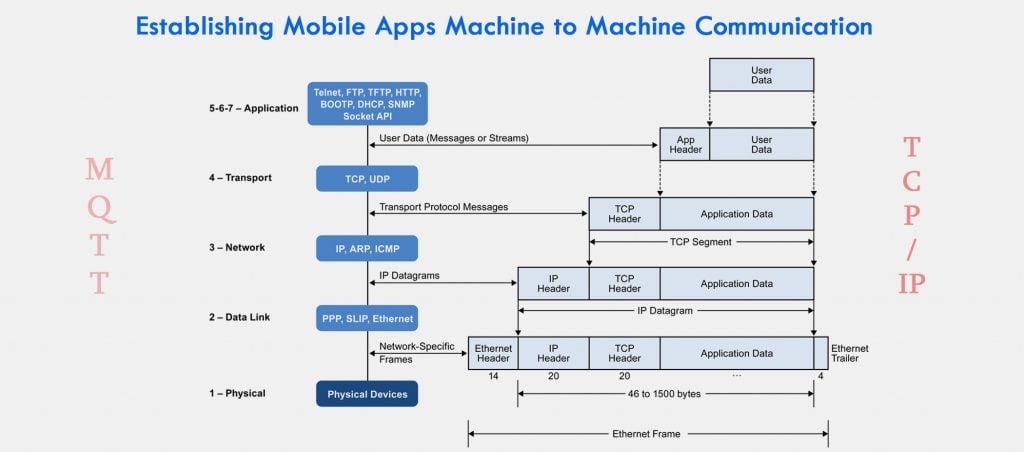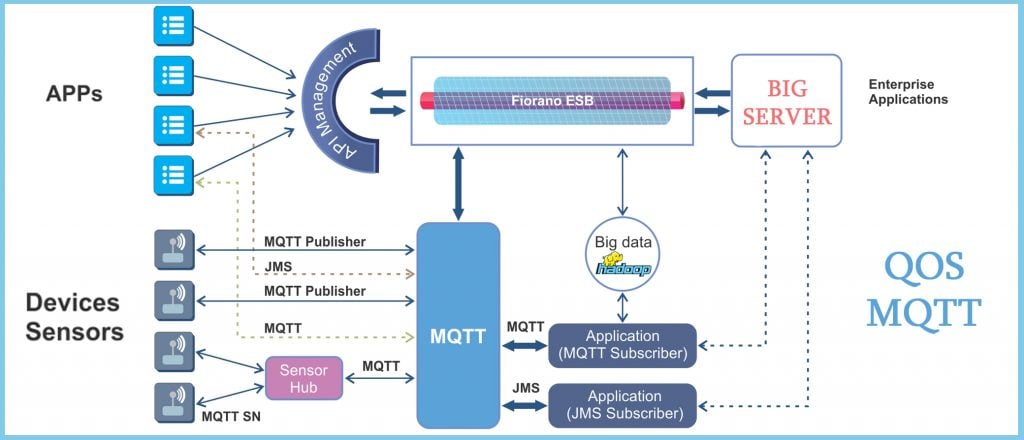These days, Internet networks primarily rely on either IP version 4 or IP version 6 in their networking stacks. Now we are discussing all about how a basic communication app development happens using the different OSI layers combination.
Discussing the development of communication apps between network sources based on the OSI model established by ISO, where protocols are combined into layers to facilitate communication between apps on different network sources.
Physical Layer:
A bit base stuffed through data (i.e., characters, symbols – bits or images, and videos – pixelated) is in bits represented across a physical layer medium in networking apps development with standards includes IEEE 802.3 (Ethernet), IEEE 802.11 (Wireless Ethernet) regardless of networking mediums.
Data Link Layer:
Is always responsible for linking formation of data packet delivery as an input to network layer. In social communication apps development similar to WhatsApp data link layer plays a significant role for information (data packets) identification on favoring performances of the messaging apps development by operations like sequencing messages with error check, media access management, getting and throwing acknowledgements through frames traffic control over the header popping and pushing addresses. Few protocols used alike High-Level Data Link Control (HDLC), Asynchronous Transfer Mode (ATM), Point to Point Protocol (PPP) and Frame Relay.
Network Layer:
Not only brands the stream of traffic routing judgments but also offers traffic control on packets routing by performing operations like logical addressing using Internet Protocol (IP addresses) and Fragmentation of packets. Network layer is supreme common network for IP addressing in Internet using devices. In Networking app development also uses similar protocols like Internet Group Message Protocol (IGMP) and Internet Control Message Protocol (ICMP).
Transport layer:
Serves to the network layer by tanking responsibilities of messages segmentation and acknowledgement delivery to help in traffic control using sessions multiplexing. The Transport layer mainly helps in chat apps development to perform the error detection and corrections over message reorganization to ensure message sequence (and also sends the request for missing messages) as a reliable message channel. In mobile apps development using transport layer comprises with protocols like User Datagram Protocol (UDP) and Transport Control Protocol (TCP).
Session is the best supporting security supplier on establishing and terminating the interactive messages (information) interchange in any session based apps development usually take care by the session layer using common protocols like NetBIOS and Named Pipes.
Yup! The key of machine level languages apps development is – ASCII, – EBCDIC, – Unicode, is character code basically translations done using presentation layer with services like data conversion, encryption and compression. All these through Transport Layer Security (TLS), Secure Sockets Layer (SSL) and Multipurpose Internet Mail Extensions (MIME).
Different hangout kind chat apps development functionalities are hang on the application layer which allows the application for resource sharing remotely for file access, printer access in the network level management, and application layer is important layer for email integrated apps development (electronic messaging). The application layer protocols familiarly for common Internet apps development includes the Hypertext Transfer Protocol (HTTP), File Transfer Protocol (FTP), Simple Mail Transfer Protocol (SMTP) and Domain Name Service (DNS).
“The Open Systems Interconnection (OSI) developed by International Telegraph and Telephone Consultative Committee (CCITT) and Transport Control Protocol/Internet Protocol (TCP/IP) ware developed by US Defense Advanced Research Projects Agency (DARPA) at parallel times in past but still used when describing modern day protocols”
Now we are approaching the Best TCP/IP Light Weight Protocol – MQTT over Eclipse Mosquitto:
What is MQTT?
The word MQTT – Abbreviates as Message Queuing Telemetry Transport (MQTT) officially called ‘MQ Telemetry Transport’. The MQTT is a light weight message protocol used for queuing of message resources constrained of network users.
Progression of MQ Telemetry Transport:
MQ – offers the message queuing i.e. lining up of data packets from one source to another source over the missionary equipment’s at network level packet transmission.
Telemetry’ is the high end auto measurement & wireless transmission of data from remote sources.
Sensors measure electrical data (current, voltage) and physical data (pressure, temperature) at different sources. This data, along with timing information, is gathered under multiplexer procedures according to user specifications.
In the realm of packet transmission, we understand “Transport” as the process of delivering messages from receiver to sender via the network. This process operates by utilizing Transmission Control Protocol (TCP) over the network layer, facilitated by Internet protocols in various IoT applications.
Yeah its sound’s a bit new Telemetry
Telemetry is the automatic measurement and wireless transmission of data from remote sources. In general, telemetry works in the following way: (such as voltage or current) or (such as temperature or pressure). These measurements are converted to specific electrical voltages.
The voltages, into a single data stream for transmission to a remote receiver. Upon reception, the data stream is separated into its original components and the data is displayed and.
“MQTT is a connective protocol complete machine-to-machine (M2M) protocol / i.e., Internet of Things protocol” – with auto message updates!
What MQTT Offers in apps development?
MQTT applications automatically measure and deliver alerts based on various scenarios through MQTT clients on mobile applications. MQTT facilitates device application development with Quality of Service (QoS), ensuring message delivery between sender and receiver through three different agreements.
-
At most once:
Clients acknowledge that the basic Internet Protocol network delivers messages to the best efforts, recognizing that message loss might occur. The quality of service is with interactive ambient sensor data.
-
At least once
By agreeing to this, clients ensure that their messages arrive, but duplicates might occur.
-
Exactly once
By agreeing to this, clients guarantee that their messages will arrive precisely once.
Application development approaches in MQTT:
MQTT machine apps setup follows a few tactics in communication providence over the network on both cloud and direct communications applications. i.e.
- MQTT Connect: Client need to wait and connect server for a connection establishment to serve messages.
- MQTT Disconnect: Client wait for until they done (finish) communication or any other work. The MQTT TCP/IP session has disconnected so far.
- MQTT Subscribe: Client need request server to let the client subscribe to the list or one topics (scenario for an instance weather reporting messages).
- MQTT Unsubscribe:Client need to request the server to let remove from subscribed list or group (to unsubscribe) in different scenarios.
- MQTT Publish: Client returns immediately to application thread after passing request to the MQTT client.
MQTT Server Mosquito Request Response – IOT mobile Apps:
In MQTT IOT mobile apps development the request and response server plays ultra-important role over the communication and synchronization of data publish to send subscriber list or to receive from different machine sensor networks.
The MQTT mobile app developers majorly think twice on the architecture development given by the professional network apps development administrators planning of MQTT architecture.
As shown MQTT mobile apps development architecture has a combination of two different areas synchronization for IOT apps development using Eclipse Mosquitto.
Middle ware Management:
Is like a three tire management service in-between the device level network level and data base level to make Internet of things connected for processing information.
Sensor Devices Management:
Accuracy is crucial when gathering necessary information for device setup, especially during the initial setup using embedded systems metrics and instrumental sciences.
API’s Management:
Takes from the major obligation with Internet of things API development for mobile and machines applications connection usually took more. Developers must need to maintain and managed accurately over the network communications.
Enterprise Applications Management:
Derived from a vast array of applications, our enterprise solution efficiently manages and interconnects devices and remote apps over servers, networks, and databases, facilitating seamless communication between machines and applications.
Wireless Sensors Management:
Sensory network is something like a networking always working to gather information and pass it to a data base. It collects major data inputs.
Network Systems Management:
Is major part to create data transformations using big server’s network for combining a smaller to larger applications and machine system.
“A device strategy to send info about assumed topics to a server acting as an MQTT message broker. Then the broker pushes (sends) the info out to the clients that have earlier subscribed to the client’s theme. All though following operation taking place in application development. ”
- MQTT broker
- MQTT Broker Push
- MQTT Broker Publish
Messaging services utilize the transport layer for transmitting data from servers to users and devices, employing push and pop operations.
Server Push: To send information (data) to server for storing.
Server pop: To send information (data) to users (IOT apps applications)
Get connected with us for more information – IOT, Enterprise chat applications similar to Google Hangouts, mailing system using high end, open source servers and protocols’ from experienced developers for you.






